Na ‘Ohana Holo Moana: Gathering of Eight Voyaging Canoes at Taputapuatea, March 1995
(From a Publication by the Ministry of Culture and the Department of Traditions of the Centre Polynesien des Sciences Humaines (CPSH.)
Three canoes have sailed from Hawaii and two others from the Cook Islands. They will rendezvous in the Society Islands with a New Zealand canoe and two Tahitian canoes.The canoes will meet beforehand in Fare, Huahine, Thursday, March 16, 1995 at the latest, for various formalities, maintenance, repairs, provisioning, and the decoration of the canoes.
On Friday, March 17 the inauguration and reopening of the marae Taputapuatea will take place.
Ceremonies, festivals, artistic and cultural gatherings will be organized by the local people as well as by the many delegations coming to this convocation, which is of interest to all of Polynesia.
Initiatives by individuals, associations and institutions, both official and private, have contributed in many ways to the realization of this project. The backers and organizers of this enterprise are far too numerous to be credited here. In a sense, each of us can find them by following local and international news, or, better still, can meet them by participating in the events of this historic gathering.
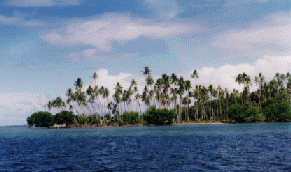
Matahira Point, Ra'iatea, Tahiti Nui, the site of the marae of Taputapuatea
Order of Protocol for the Canoes
Toward 8 A.M. the canoes will enter the passage of Te ava mo'a, which will be marked with revareva (flags?) planted on the reef, respecting the following order of protocol:
- Te ‘Aurere, Aotearoa
- Te Au o Tonga, Rarotonga
- Takitumu, Rarotonga
- Hawai'i Loa, Hawai'i
- Hokule'a, Hawai'i
- Makali'i, Hawai'i
- A'a Kahiki-Nui, Tahiti
- Tahiti Nui, Tahiti
The canoe Rau Hono, built of reeds in the Rapanui tradition, will also try to participate in this event.
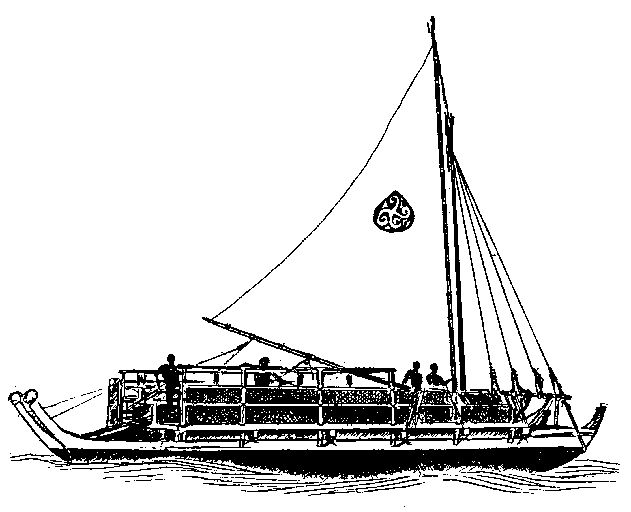
Te ‘Aurere (Aotearoa)
TE 'AURERE was built in Aotearoa, New Zealand, and its name suggests "the movement of a misty cloud." I's hulls have been hollowed out of two centuries-old kauri tree trunks. Its builder had earlier constructed the two large ceremonial canoes, MATAATUA PUHI and TE IKI A MAUI.
In 1992, the year of its maiden voyage, TE 'AURERE sailed round-trip to Rarotonga, Cook Islands. This canoe is dedicated to the training of young Maori crews in the art of traditional navigation.
Length: 57' / Height of storage area: 10' / Beam: 16' / Displacement: About 10 tons / Height of the prows: 4' / Crew: 10
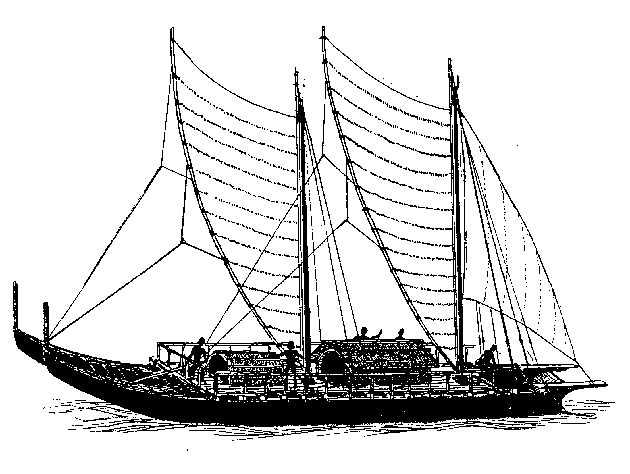
Te ‘Au O Tonga (Rarotonga)
TE ‘AU O TONGA means "the mist of the South," the name of the canoe of Karika, a Samoan chief who settled on Rarotonga about six centuries ago, during the Tangiian epoch.
Made of laminated, while respecting the original model of the TIPAERUA, it has hulls of equal length, which end at the bow in decorated vertical extensions, and take the form of horizontal planks at the stern.
About one hundred persons united their efforts in moving the two hulls of this canoe from the TAKUVAINE Valley to the beach in order to assemble them. In a rare turn of events, a thick fog enveloped the entire island on this day. According to the sages, the canoe thus received the blessings of the TUPUNA.
Length of hulls: 72' / Displacement: 10 to 12 tons after lading / Draft: 2'1" / Crew: 18
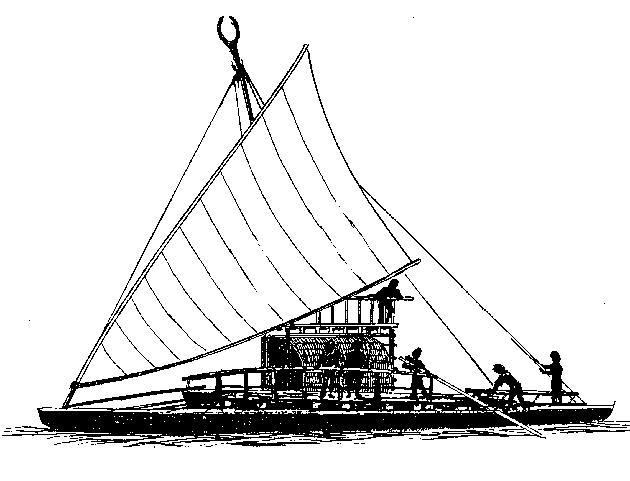
Takitumu (Rarotonga)
TAKITUMU means "the burden is removed." It is the name that TANGIIA, chief of Rarotonga, gave his canoe after his victory over his brother TUTAPU, some six hundred years ago.
The new TAKITUMU has been built of laminated wood, modeled after the first TAKITUMU; its hulls are asymmetrical, its rigging is that of the Fijian NARUA, and its binnacle is of standard make. A gift to the MAIRE NUI in Rarotonga in 1992, the TAKITUMU has since made a round-trip voyage to the Society Islands, in 1993.
Length of the big hull: 53' / Length of the small hull: 49' / Displacement: 7 to 8 tons, laden / Draft: 2' 3" / Crew: 10
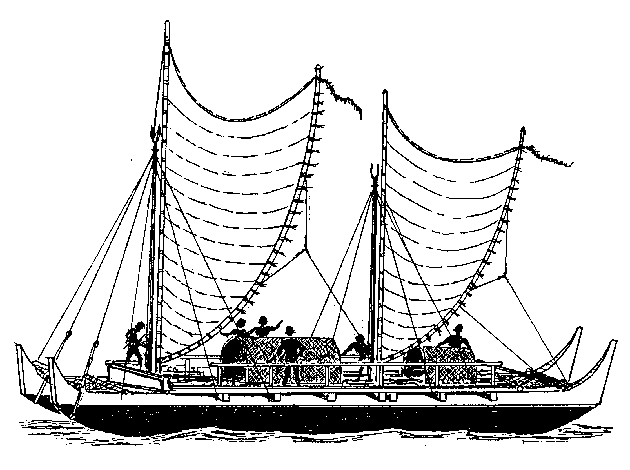
Hokule‘a (Hawai‘i)
HOKULE'A is the Hawaiian name for Arcturus, the zenith star of this archipelago. It is the 'mother' of contemporary, double-hulled canoes. With its design taken from old engravings, but built with modern materials, it has plied the waters of the Hawaiian archipelago for twenty years. It has sailed several times to the Society Islands (1976, 1980, 1992); from 1985-87 it completed a voyage of 12,000 miles to Tahiti, Rarotonga, Aotearoa, Samoa, and return.
A training canoe, HOKULE'A has earned the title on more grounds than one, since it has taken on board several hundred classes, and since its voyages have been followed by more than ten thousand student sailors. It is, likewise, aboard the HOKULE'A, that Mau Pialug, master Micronesian navigator, has taught more than twenty apprentice navigators.
Maximum length of hulls: 62'4" / Total Sail: 540 sq. ft. / Length at waterline: 54' / Displacement: 11 tons after lading / Draft: 2' 6" / Crew: 10
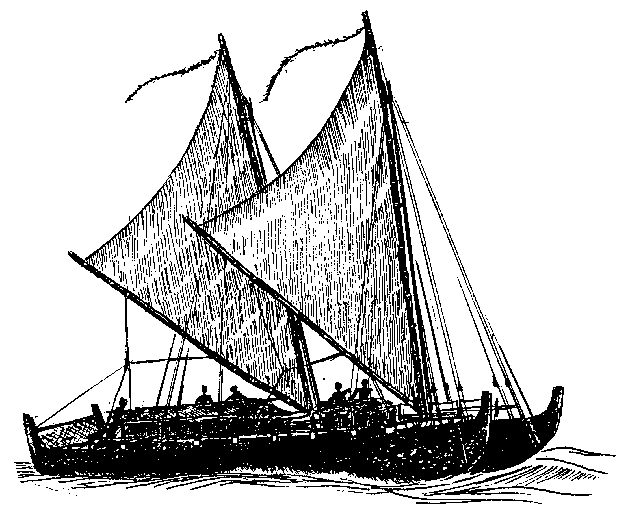
Hawai‘iloa (Hawai‘i)
HAWAI'ILOA is the name of the chief who discovered the Hawaiian archipelago. The hulls of this canoe have been hollowed out from two gigantic spruce trunks, given by the Tlingit and Haida Indians of the island of Shelikof, Alaska, after a fruitless, six-month search in the koa forests of Hawaii.
The local woods, such as koa, hau, and o'hia, have been used to make the masts and the beams, and for securing the prows and the gunwales. The ropes are of natural fiber, nape purau, and the sails are of woven pandanus. For about a year a beginning course in traditional navigation has been offered aboard the Hawai'iloa for the school children of Hawaii.
Maximum length of hulls: 57' Crew: 12
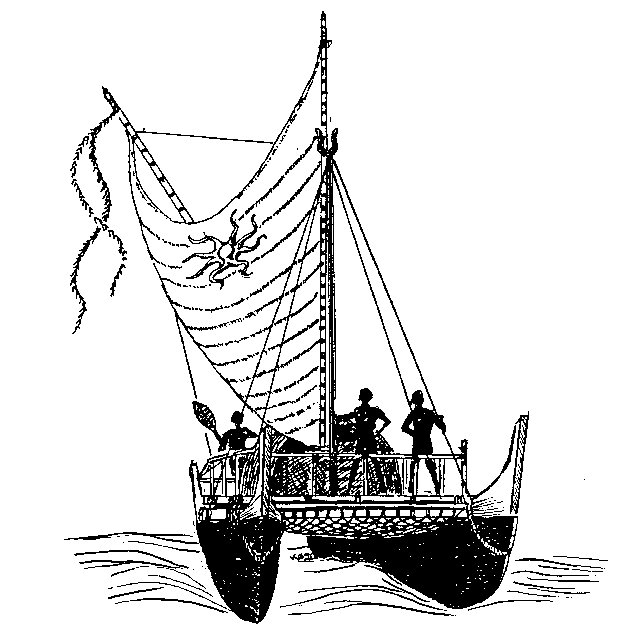
Makali‘i (Hawai‘i)
MAKALI'I is the Hawaiian name of the Pleiades star cluster. MAKALI'I was also the navigator of Chief Hawai'iloa's canoe.
It is on the west coast of Hawaii, the Big Island, that this canoe was built, on the initiative of former members of HOKULE'A's crew. We must emphasize that this achievement has represented a considerable effort, both moral and financial, for the families who have invested in this project. Of traditional construction, it's prows are narrow and deep; it is made entirely of modern materials. This is MAKALI'I's maiden voyage.
Maximum length of hulls: 54' / Total Sail: 500 sq. ft./ Length at waterline: 47' / Displacement: 65 tons after lading / Draft: 31 / Crew: 10
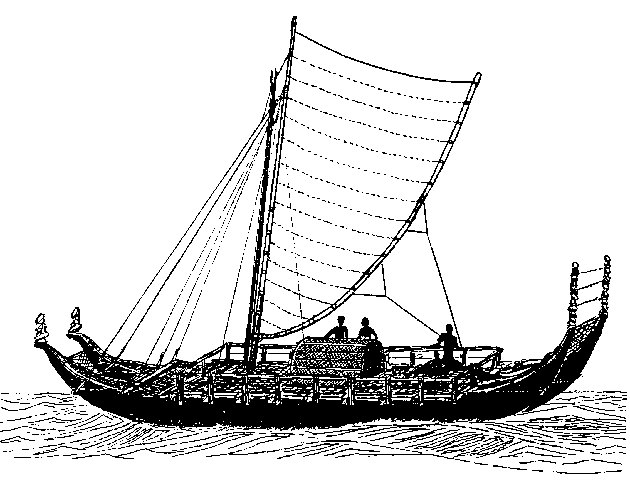
‘Aa Kahiki Nui (Tahiti)
For 'Aa, which has one of the names attributed to the star Sirius, at the Zenith of the Society Islands, this voyage will also be a maiden one.
It was built of 'URU for the base of the curved prows and some of the planks, of DAKOA and KAORI for the deck, of 'AITO for repair work and reserve spars; other local woods such as MARA, 'AUTERAA, 'AI-TO, and PURAU VARI, have likewise been used for different parts of the canoe.
Length: 45' / Total Sail: 530 sq. ft. / Maximum height at the prows: 6' 2" / Draft: 2' 3" / Estimated displacement: 4.4 tons after lading / Crew: 8
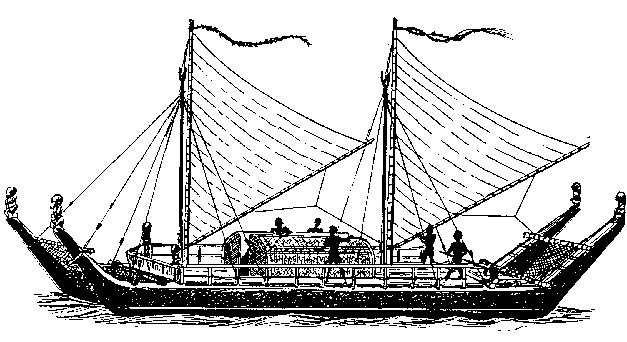
Tahiti Nui (Tahiti)
TAHITI NUI is the longest of the eight canoes in the flotilla, and will be launched for the first time on the occasion of this assemblage. From the old canoe, HAWAIIKI NUI, two beams of TOTARA wood have been salvaged. These form the base for the hulls. The side pieces, the timbers, the deck and the masts are of DAKOA, and the cross-pieces of pine.
Many young Tahitians have participated in the building of TAHITI NUI, in particular the ornamentation and carving of the two prows.
Length of hulls: 75' / Total Sail: 925 sq. ft. / Maximum height of the prows: 6'2" Draft: 2'3" / Displacement: About 12 tons, laden / Length at waterline: 62'3" / Crew: 12
Program Planned for March 18, 1995
Taputapuatea, Opoa, Ra'iatea
Draft translation by BJ Short 1/31/95 Taputapuatea
Raymond Graffe, aboard the canoe Te Vaka 'Uritaua, will greet them one by one. Pierre Sham Koua will proceed to a Pi'i (call) from the beach. Raymond then rejoins Pierre on the beach for the continuation of the ceremony.
Each canoe will be at its determined place of anchorage (To'ahiva or Hotopuu).
The crews will be dispatched towards the beach by a decorated barge, always in the same order of protocol as in the entry to the passage. Each group of crew members will go into the water, at around 50 meters from the bank, and will walk to the shore, passing by a marked corridor of ancient revareva flags.
Maro Tai
Before reaching firm ground, the crews will execute the ritual of the Maro Tai: Each member of the crew will deposit a small stone of coral that he will have brought with him from the lagoon. This gesture being an offering to Ruahatu and to Tane, gods of the Ocean.
Pohaku, Toka, To'a
After having reached firm ground, the crew will halt at the altar of the sacred stones Te Ahu Ti'araa Toa Mo'a, which is situated half-way into the great marae Taputapuatea. During this stop, each group of crew members will deposit its sacred stone on the altar, in the planned place, and will continue its route towards the marae. These stones will mark the passage of the canoes at Taputapuatea and will contribute to restore to the great marae of Taputapuatea its true place at the center of the Polynesian triangle as a place of International gathering of the peoples of the great Ocean.
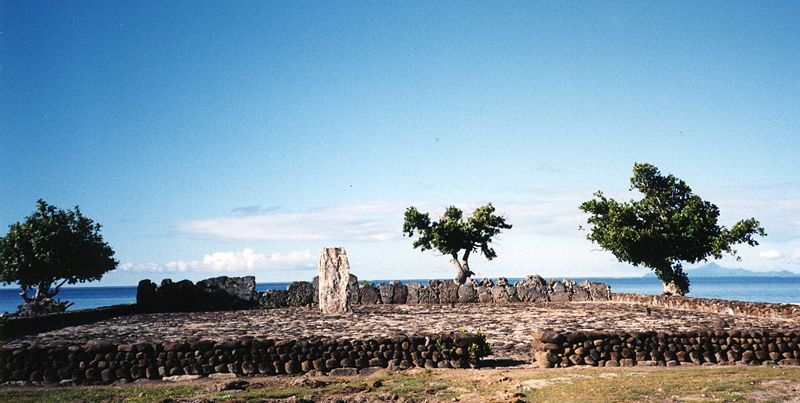
Taputapuātea, an ancient marae at Ra'iātea in the Society Islands, restored in 1994.
Aha Mo'a
When all of the crews have taken their places on the great marae of Taputapuatea, the ritual of the Aha Mo'a will proceed. Each group will bring to this occasion a piece of (???) 90 cm. (3 ft.) long. (I think this is sleeping sennit, 'aha moa : Bishop Museum Bulletin 48, Ancient Tahiti, by Teuira Henry, mentions such a travel ritual involving a piece of sennit about 1 ft. long, first put under the outrigger of the canoe and then placed by a priest beneath a sacred slab, invoking the care of the gods on th e voyage.) It concerns a ritual that the crews in times past used to observe at the end of a long voyage. They used to come thus to the marae to thank the gods for their protection during the voyage. The aha mo'a was then buried under a stone of the surro unding wall of the marae, where it remained forever as an offering to the gods. This ritual will be observed at the occasion of the great gathering of the canoes at Taputapuatea.
Inuraa 'Ava
A ceremony of the Inuraa 'ava will conclude the ritual part of the gathering of the canoes. Considered in former times as a sacred drink for the gods and high priests, it was also the drink that sealed alliances and reconciliatlons between clans and peopl es. And it is precisely in the framework of the rehabilitation of the alliance Te Hau Faatau Aroha that this ceremony of the Inuraa 'ava is situated (rooted, takes place).
'Oa 'oa Raa
At the conclusion of the ceremony of the Inuraa 'ava the part consecrated to celebrations will begin. Each delegation will be able to express itself according to the established order of protocol. Oratory (public speeches), chants (songs), dances will fol low in the original language.
At the end of the celebrations, Raymond Graffe and Pierre Sham Koua will take the stand (speak) to announce the end of the ceremonies before 3 P.M.
Taputapuatea Traditions, September 1994
Draft translation by BJ Short 2/1/95
The arrival of the canoes at Taputapuatea forecasted for the year 1995 naturally directs each person to measure the importance of the event and to try to place it in the unfolding of our history. May these few reflections issued from a working group in the heart of the department of traditions contribute to sustain (uphold) the effort of each person in the preparation of this encounter.
1. A stone of Vaeara'i, called Te-Ra'i-Tuatini, was transported to Matahira point to found Tini-rau-mata-te-papa-o-Feoro, also called Vai'otaha. Hiro, the great navigator who wove the bonds of the great alliance, Te Hau Atea or Te Hau Faatau Aroha, made of it the center of the meeting (reunion) and gave it the name of Taputapuatea.
O Taputapuatea te marae, o Pupua te fenua,
Ia farara mai ra te mata'i ra e Maraai,
E Maraai fe'uti'uti no te tai roa i Pupua
Te tahua Matatii Tahua Roa.
2. Numerous canoes left from there (in the distant past) and some of them returned. Today, 8 canoes are preparing to return to Taputapuatea:
Te ‘Aurere, Te Aotearoa
Te Au o Tonga, Rarotonga
Takitumu, Rarotonga
Hawai'i Loa, Hawai'i
Hokule'a, Hawai'i
Makali'i, Hawai'i
A'a Kahiki-Nui, Tahiti
Tahiti Nui, Tahiti
They will enter by Te Ava Mo'a, the passage which was made mo'a (sacred) at their departure:
No 'oe i taimarahia ai o Ra'iatea
Eiaha te auahi ia 'ama, eiaha te moa ia totara,
Eiaha te 'uri ia 'aoa.
3. It is the hour (time) for the meeting of the canoes. It is also the opportune moment to renew the vital bonds that unite all Polynesians. All have used the canoe to discover the island which would become their new 'ai'a (native country, according to Li brary's Tahitian dictionary).
4. At the time of the unification of the fare metua (fare means house, metua means parents in Tahitian dictionary), all individuality will obliterate itself to put itself at the service of the whole family; each canoe that sets out again from Taputapuatea will be the messenger of the family.
5. If symbolically Raiatea is the Father, who reveals the role of each one, Tahaa is the mother, who nourishes with Love. To recognize Tahaa, is to recognize the mother. It is there that Hiro received the teaching, close beside Faimano, his mother, and 'A na, his grandfather.
6. The canoe contains the essential values that one wants to safeguard for the tere (voyage) towards the 21st century.
7. The name of this tere (voyage) will reveal the poro'i (message), message destined for the children of the 21st century. The message will define the work to be done (accomplished) by the Maui of the future.
The Double-Hulled Canoe
In ancient times the canoe was at the center of daily life and of all the important events of the Polynesian community. Simple, single-hulled canoes for fishing, or merely pleasure-paddling, lining up for a sailing race, or moving from one island to another, heavy war canoes, paddled to the beat of the PAHU, canoes for ceremonies, canoes for boat parades, the designs were rich and varied, and the styles differed from one archipelago to the next. But above all, the Polynesians gave substance to the science of navigation, and demonstrated their art of canoe-building with their great, twin-hulled, voyaging canoes, or VAA-TAUATI.
It was imperative that the construction resist the violence of the storms, that the setting of the sails and the rigging be secured with great care. Several families would embark for an undetermined number of weeks with provisions, with plants and domestic animals, tools and all that would permit them to settle in a new land.
Thanks to their vision and planning, even the heavily loaded canoes were not only manageable, but fast enough to undertake long voyages, non-stop. It is no accident that, several centuries later, the building of competitive catamarans is still inspired by the work of these mariners' forefathers.
Traditional Navigation
Without map, or sextant, or compass, or chronometer ...
To guide the canoes on their ocean voyage, the Polynesian navigators had only their gift of observation and the knowledge inherited from their fathers. Down the line, from generation to generation, they had learned to follow the path of the stars, to know the winds and the currents, to read their route in the constellations, and to interpret the smallest visible sign in the formation of clouds or on the surface of the ocean.
All that floats, swims, or flies is a priceless indication: the flotsam and jetsam, the birds that return each evening to nest on their island, the turtles that return to lay their eggs in the place where they themselves were hatched, the whales and dolphins who take up their seasonal migratory routes.
After years of apprenticeship, the navigators had memorized the path of each star, it's rising and it's setting, and for each island the star that passed at all it's zenith. Thus, to relocate Raiatea, all the canoes will converge toward TA'URUA HAU PAPA, also called 'Aa or Sirius, Raiatea's zenith star, the largest and most brilliant in all the heavens.
Ports of Call in Polynesia
Huahine
This island was once called MATA'IREA. The reef passage that leads to the main village, FARE NUI ATEA, has, as at OPOA, the name of TE AVA MO'A. The mountain that overlooks FARE is named TURI, another celebrated navigator of RA'IATEA. The term TI'ATURI today means "to have faith in," which is indeed appropriate to the attitude that everyone should have for the first day of rendezvous.
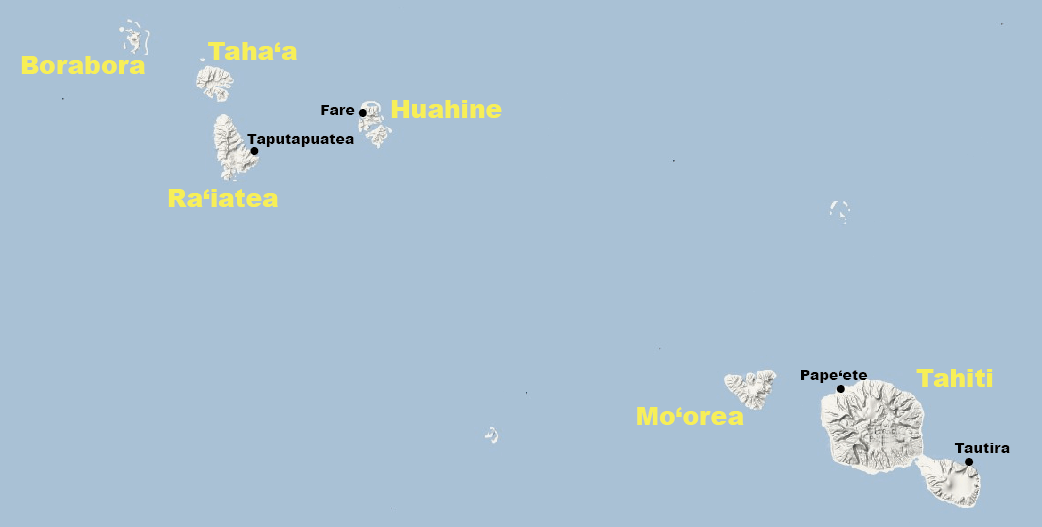
Taha‘a
It is at 'UPORU TAHAA that the voyaging chief Hiro was born. His mother was 'chiefess' of FAAAHA, and his father, MOETERAURI, was and intrepid navigator who lived at times in VAVAU, BORA BORA, and at other times in HIVA, RA'IATEA. He was also the builder of great canoes in which he sailed as far the Marquesas Islands, Tuamotu, Hawaii. Worthy son of his father, Hiro was also one of the most brilliant students at "TAPU ATA I TE RA'I" the illustrious school founded by his grandfather, 'ANA, before becoming the legendary navigator that we all know.
In the steps of Hiro, this visit will be a tribute to all Polynesian navigators; it also marks the rebirth of the art of navigation by the stars.
Pape‘ete [capital of Tahiti Nui, on the west end of Tahiti island]
At the VAI'ETE spring people used to come to draw water, VAI or PAPE, water that they would carry in gourds nested in baskets, or 'ETE. The remembrance of this custom resulted in the name of the city, VAI'ETE, PAPE'ETE.
Even today the navigators will replenish their water supply with water from the rock of FAUTAU'A before their departure for the Marquesas.
Tautira [village on the east end of Tahiti island]
Called also FATU-TIRA, the "master of masts," this district at the tip of Tahiti's peninsula has always enjoyed a privileged relationship with the Leeward Islands, and share with them many legendary tales.
Thus, the two princesses, URU MA RA'I HAU and URU MA RA'I TAPU, came to these islands aboard AERE, their double-hulled canoe, disembarked, and were married. The grandson of one of them was the famous HONO'URA, a giant warrior whose name meant 'the sacred bond." The stop at Tautira will, without doubt, give vital strength to the sacred bond that unites the eight canoes on this voyage.
Taputapuatea
In the course of past centuries many MARAE were constructed on the broad point that bears the name MATAHIRA ITERA'I. It extends between the bays of TOAHIVA and HOTOPUU, and faces TE AVA MO'A, the sacred passage that leads to the open sea.
Hiro, the legendary navigator, once made it the center of the Alliance: TE HAU FAATAU AROHA, to the west of RA'IATEA. All these islands would regularly send, as delegates to OPOA, their sages, their priests and their warriors, to gather there and share their knowledge.
Today, and for the first time in centuries, eight canoes will once again negotiate the passage TE AVA MO'A, in order to rejoin TAPUTAPUATEA. Their crews come from distant Polynesian islands to reaffirm the bonds that unite and revitalize this ancestral alliance.
The canoes epitomize these values which the crew members have shaped: a thorough knowledge and respect for the forces of the ocean, the cohesiveness of the group, the spirit of adventure and the risk, freely accepted, the conviviality and the tolerance, the togetherness and the confidence. On the open sea and reduced to a double-hulled canoe, these words take on their full meaning, in the face of foul weather and far from any landfall .....
This heritage constitutes the most precious opportunity for the canoeists to undertake another voyage: one they will undertake today as a benchmark for the next thousand years!
Nuku-Hiva
"One day, a very long time ago, ATEA and his wife ATANUA decided to build their house in the middle of the ocean.
Singing and dancing, ATEA invoked his gods: AKA-OA E, AKA POTO E, AKA-NUI E, AKA-ITIE, AKA-PITO E, AKA-HANA E, HAKATU TE HA'E.
Two posts were erected: UA-POU. A long beam was placed on the two posts: HIVA-OA. The beam, the posts, the roof both front and rear, were assembled: NUKU-HIVA. Nine sections of woven palm fronds were necessary to cover the house: FATU-IVA. The light of day brightened the sky: TAHU-ATA. MOHO, the bird of the morning, was already singing: MOHO-TANI. ATEA dug a hole to store the surplus leaves and coconut milk: UA-HUKA. Their house finally built, ATEA's wife shouted:"EI, EI EI UA AO, UAAO: EIAO...."
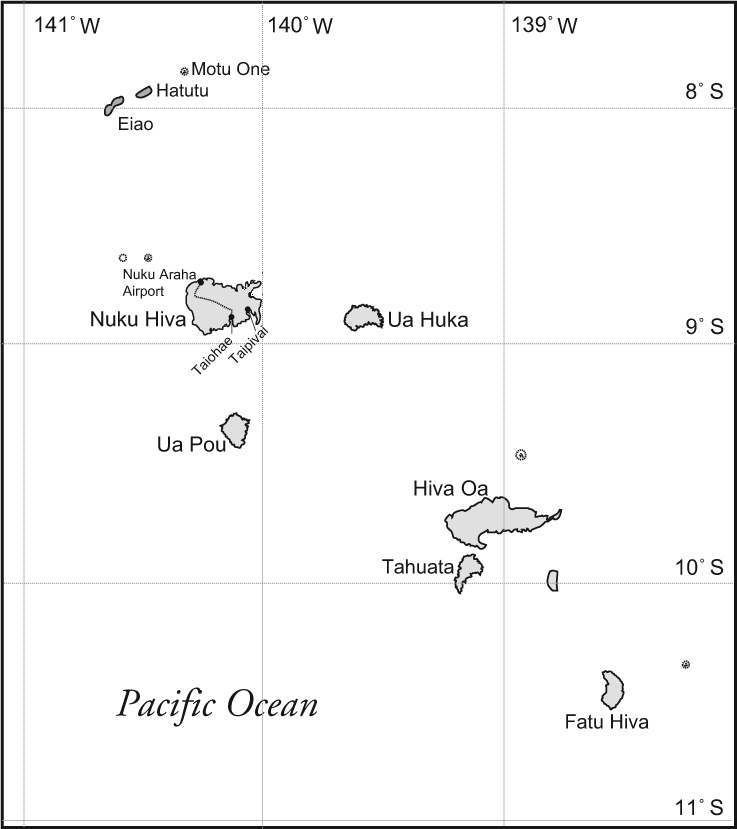
On the occasion of the Marquesan Festival of the Arts, six years ago, RENE HAITI, called UKI, recalled the legend of the creation of this archipelago. Standing on the PAEPAE PIKI VEHINE he gathered together the delegations from each of the Marquesa Islands, in order to give them the message of FENUA ENANA, the Land of Men: "At the beginning of a new era man returns to his familial home to nourish himself in the light of knowledge and to draw a new breath."
It is the same message or call to which the flotilla of canoes is responding today.
O‘ahu
More than five hundred years ago the canoe of RAA MAI TAHITI put in at KANE'OHE. It brought to this place the first PAHU, which spread the message: AROHA NO HAVAI'I NUI to the eight islands of the Hawaiian chain.
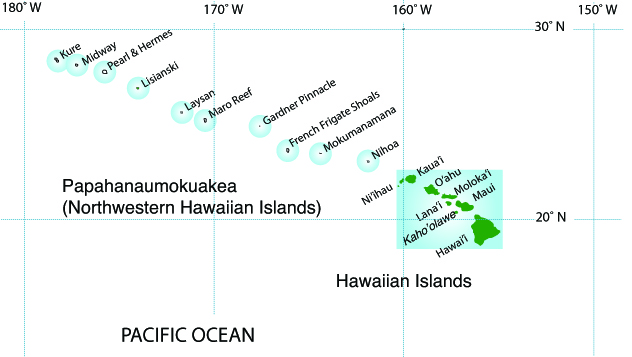
Te Fe'e (The Octopus)
TAUMATA FE'E and TUMU RA'I FENUA are two of the names of the great FE'E, pictured as an octopus, whose head is situated in Ra‘iatea [Havai‘i] and whose tentacles extend to MOANA NUI A HIVA, tracing the routes of the canoes to the various islands of the Great Ocean.
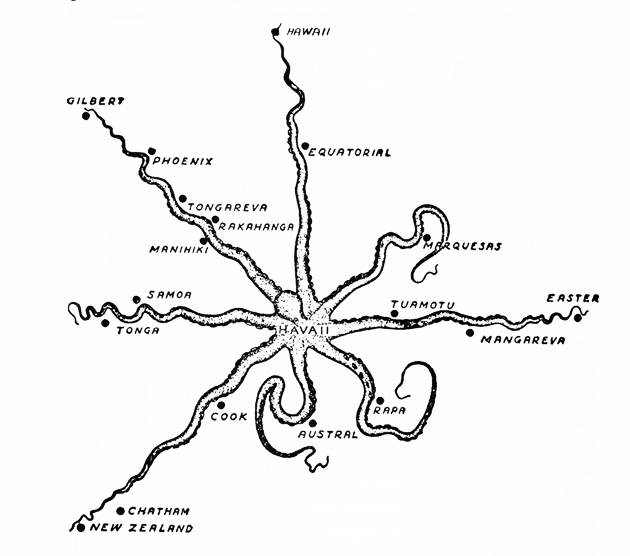
Each of these routes corresponds to a star path in the sky.
TE ARE O TE MOANA, guardian of the sea, opens the way to the voyagers, once they discover and take full advantage of the true worth of the great FE'E.
TE HAU, TE MAITA'I E TE HO'ERAA. Peace, goodness and unity. Only these qualities can carry them to their destination and bring them back, at the chosen time, to the land of their origin, Hawai'i.
